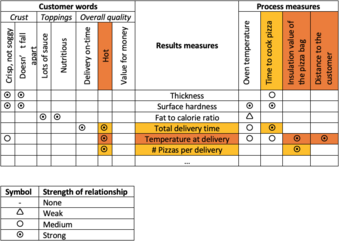
Linking measures to the voice of your customer
Progress indicator

Dennis Crommentuijn-Marsh, Director Consultant, Practice Head Data Analytics and Insights at PMI, looks at the process for linking measures to the voice of your customer.
True quality characteristics are those that relate to your customer’s requirements. In order to meet these requirements, we need to be able to identify and measure the processes which are designed to meet them, i.e. we need to link the customer to our processes.
By developing causal links between them we can establish which process measures we should improve, and which improve results measures and customer satisfaction.
Process for establishing the right measures
1. Capture the voice of the customer (VOC)
- Use interviews and surveys to capture the customer’s own words regarding their requirements: e.g. “how do you like your pizza?”
- Convert their words to simple expressions limited to a single thought and ensure they are operationally defined. For example, “I like my pizza hot” à“hot” = temperature at point of delivery measured in degrees Celsius at the centre of the pizza using a calibrated non-contact infrared thermometer.
- Categorise the re-worded data (“hot”) and assign major headings.
2. Deploying customer needs into the process
Now that you have your customer’s requirements, you need to link them to product or service characteristics and measures. To do this, two matrices are used. The first defines the relationship between the customer’s words and the identified results measures. The second shows the relationship of the results measures to the process measures.
a. Develop the results measures – VOC matrix relationships
- List current result measures to check whether customer requirements are being met.
- Define the relationship between the customer requirements and the result measures using a matrix.
- Identify any customer requirements which need additional result measures.
b. Develop the process measures – results measures matrix relationships
- Identify which requirements are most important to your customer and which results measures are more in need of improvement.
3. Developing the matrix
There are two established ways to display the matrices, the two L-matrices, or my favourite, a T-matrix. The T-matrix has the benefit that you can see the key relationships between voice of the customer > results measure > process measures (VOC àRM àPM) within a single picture.
When developing your matrix, use symbols to express the strength of the relationship. Remember, these are subjective based on your experience of the process of interest.

Now you can express the causal link in a logic chain and assess what you should measure within the process that influences customer feedback. The assumption is that by improving the process measure, you improve the results measure, which in turn improves the customer response.

Are you measuring too much?
If the measures are not linked to the voice of the customer, challenge yourself on whether you truly need that measurement. You may find that an internal customer requires one measure and the external customer a different one (efficiency versus effectiveness).
If you are not measuring enough, develop new measures that are directly linked to the respective customer feedback. Where possible, test them first small-scale and then roll them out.
Hints and tips
- Ensure that all words and measures are operationally defined so there is no room for misinterpretation, otherwise the exercise can become extremely challenging.
- Use symbols, not numbers, otherwise people will want to apply mathematical operations to them.
- Where needed, verify any subjective assessments with data.
Don’t forget your customers!
Don’t forget, the process for selecting the right measures will only yield the best results if we are actively engaged with our customers. Only then will we know what measures to choose.
Quality World

Get the latest news, interviews and features on quality in our industry leading magazine.


